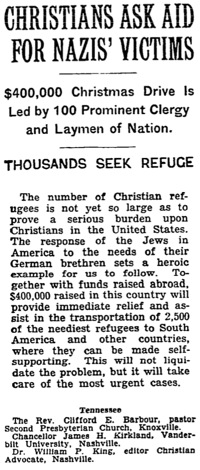
U.S. doors were closed
"Assist in the transportation of 2,500 of the neediest refugees to South America and other countries"Vanderbilt University Chancellor James H. Kirkland was one of two Nashvillians and one hundred Christian Americans who signed a letter seeking public support for Christian refugees from Nazi Germany, according to an article in the December 21, 1936 New York Times. The funds raised would be used to send non-Jewish German refugees to "South America and other countries". The letter implies that Jewish refugees were to be taken care of by Jewish Americans, by offering this bit of praise: "The response of the Jews in America to the needs of their German brethren sets a heroic example for us to follow."
Why the letter would say both "the number of Christian refugees is not yet so large as to prove a serious burden upon Christians in the United States" but at the same time support their relocation outside the United States and not immigration reform to the U.S. is a nuance not explained by the article.
Perhaps the growing U.S. restrictions against German immigration were seen as unchangeable status quo, or a necessity to ensure U.S. self-protection. See below.
This 2007 Times article explains how national security fears shut down America's legal immigration even indirectly related to Germans: "By June of 1941, no one with close relatives still in Germany was allowed into the United States because of suspicions that the Nazis could use them to blackmail refugees into clandestine cooperation."
According to the 2007 article, one of the targets and victims of that national security policy, and the tight immigration controls even before 1941, was Anne Frank. Her father Otto Frank applied for U.S. visas in 1938 and 1941 and was denied both times.
An excerpt of the 1936 article is pictured in the right-hand column of this post.

No comments:
Post a Comment